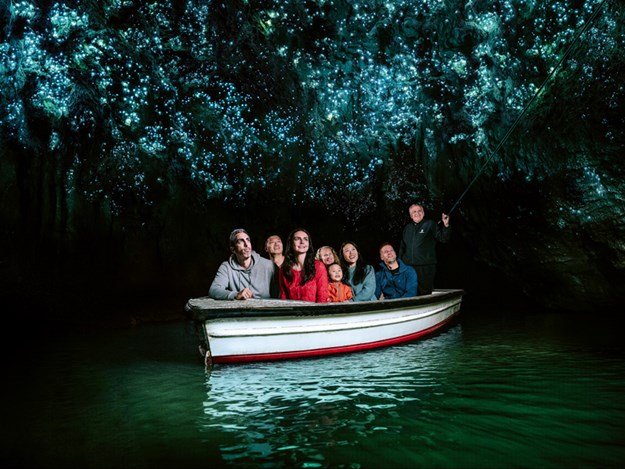Waitomo, Waikato
One of New Zealand’s most popular tourism destinations, the Waitomo Caves are in the heart of the King Country and are formed of hundreds of caves — about 400 have been identified so far. Every year, thousands of tourists flock to Waitomo to see the glow-worms and incredible limestone formations. There are options to see the caves on an underground boat, a black-water raft, and along a subterranean walkway.
Ngarua Caves, Nelson
Nelson’s Ngarua Caves can be found within Marble Mountain in the Takaka Hill range, a 30-minute drive from Motueka on SH60 towards Takaka and Golden Bay. The caves have a wide and breath-taking variety of stalagmites and stalactites, and also a skeleton of the extinct moa on display.
Oparara, North Westland
The Oparara Basin and rainforest is 16km from Karamea in Westland and features the 13km Honeycomb Hill Cave as well as New Zealand’s largest limestone arches. The caves are renowned for the discovery of the most extensive collection of subfossil bird bones found in New Zealand. More than 50 species — many now extinct — have been discovered including moa, giant New Zealand eagle, giant flightless goose and rare native birds such as takahē and kākāpō.
Rikoriko Cave, Northland
The Rikoriko Cave, the world’s largest sea cave, is located in the Poor Knights Islands in Northland. Dive Tutukākā runs eco-tours exploring the caves, arches, and marine and birdlife unique to the Poor Knights marine reserve. The cave is renowned for its acoustics. Live concerts — including by Kiwi artist Neil Finn — have been performed in the natural auditorium.
Kawiti Caves, Kawakawa
The Kawiti Caves, a few kilometres south of Kawakawa, are also known as the Waiōmio Caves. They are home to thousands of luminous glow-worms, awe-inspiring rock formations and lush green rainforest. Guided tours are available, taking you along a wooden boardwalk through a 200m limestone cave system.
Waipū Caves, Northland
The Waipū Caves, located off SH1 near Waipū, are free to enter, but take note that the area is completely undeveloped. There are no tracks or paths in the cave, and you may need to wade through water and clamber over mud banks. The cave is in three sections with the third chamber being the best for viewing the ‘galaxy’ of glow-worms. This area also features limestone/karst rocks and boulders that have weathered into beautiful, surreal shapes.
Te Anau Caves, Southland
You’ll need to join a tour to visit these caves, but it is well worth it. The journey begins with a boat ride from the lakefront in Te Anau where you’ll then cruise through 12,000-year-old caves that have been carved by water into swirling shapes and formations. You’ll also be taken by boat into a grotto that is home to hundreds of tiny glow-worms.
Cathedral Caves, The Caitlins
The Cathedral Caves are located in cliffs at the northern end of pristine Waipati Beach in The Catlins. The caves have attracted international interest for their length — the two sea-formed passages together measure just on 200m — and their impressive height, up to 30m. They can only be reached for an hour, either side of low tide. When the tide is right, you can walk from one cave to another —but be prepared for wet feet.






